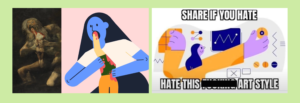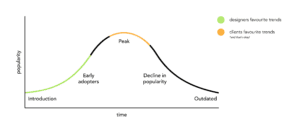
Funny thing about people who go into the arts, we tend to be quite a passionate bunch. We look at our craft the same way my gear-head dad names every cool car he sees on the street as it drives by, or the way my sister who studied linguistics gives us a seminar on eggcorns any time she hears someone say “for all intensive purposes” (eggcorns are actually a really interesting phenomenon, 10/10 would recommend googling that after you read this); the point being that designers are always observing design, because it’s our passion.
I’ll get back to talking about your design team (with less anecdotes about my family) in a minute, but right now I want to talk to you about Corporate Memphis. You may have also heard it by its original name Alegria, or you may have never heard of it at all, but I promise you’ve seen it. Alegria was originally designed by BUCK for Facebook, the style consists of flat colourful vector designs, usually of characters with unnatural skin tones and limb proportions. It’s quick for designers to produce, easily scalable, easily readable, eye-catching and inclusive, which of course meant there were copycats. Lots of copycats. Eventually this style was so widespread that the general public dubbed it “Corporate Memphis”.

Those are all different brands, can you tell?
Since this artstyle became such a phenomenon, the public started to push back. Especially in the wake of the COVID-19 pandemic, small businesses were dropping like flies while large corporations (of which this artstyle is so reminiscent) got richer. There were websites and threads dedicated to making fun of it, parodies of the artstyle and just general disdain.

Yet we still see it everywhere, it’s still the resident artstyle of the internet, and it’s still highly requested by clients. I’m not saying there’s no place in the design world for this style, as previously mentioned there’s a long list of pros; however, there is clearly a disconnect to be observed here between the public and corporations. I think this is where trusting your designers comes in.

This is a graph of how trends generally work. They’re introduced by a trendsetter, picked up by early adopters, they hit their peak and it’s all downhill from there, next thing you know they’re outdated. When a request comes in from a client, in my experience, it’s usually in the orange section. Which makes sense, the trend is peaking, it’s all the rage, you want on board! And for something like a social media post, maybe even an ad campaign, capitalizing on its popularity can work really well; but for a redesign, a new brand or anything long term, you’re hopping on a sinking ship (and paying a good chunk of money for your ticket!). It’s okay that this is what you might gravitate towards, that you’re not necessarily up to date on the latest design trends, because that’s not your job. That is why you hired us, it’s our job to follow the trends and advise you on your brand.
Your business is your baby, at the end of the day you make the call, and you shouldn’t have to compromise on your vision. But it’s safe to say a successful brand that resonates with your audience is part of your vision. So next time your design team pitches you something outside of your comfort zone, just take a minute to consider how much time you spend thinking about design, and how much time we do.
Sophie Langman , Graphic Designer + Motion Graphics
Sophie’s long-lived passion for graphic arts has encouraged her to engage in as many facets of design as she can. From branding to motion graphics, typography to illustration, or web to print, she prides herself on versatility and work ethic; always finding genuine enjoyment in her projects. During her time studying design, she learned many technical skills with software and collaborative skills with her peers. At the end of the day, she strives to take as much pride in your brand as you do.
